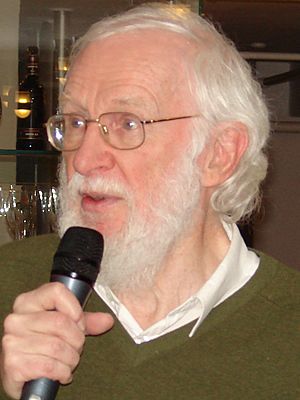Peter Naur facts for kids
Quick facts for kids
Peter Naur
|
|
|---|---|

Naur in 2008
|
|
| Born | 25 October 1928 Frederiksberg, Denmark
|
| Died | 3 January 2016 (aged 87) Herlev, Denmark
|
| Nationality | Danish |
| Known for | ALGOL Backus–Naur form |
| Spouse(s) | Christiane Floyd |
| Awards | Computer Pioneer Award (1986) Turing Award (2005) |
| Scientific career | |
| Fields | Computer science, informatics |
| Institutions | Regnecentralen Niels Bohr Institute Technical University of Denmark University of Copenhagen |
Peter Naur (born October 25, 1928 – died January 3, 2016) was a brilliant Danish computer science pioneer. He won the famous Turing Award, which is like the Nobel Prize for computing. He is best known for helping to create the Backus–Naur form (BNF). This is a special way to describe the rules (syntax) for many programming languages. He also played a big part in making the important programming language called ALGOL 60.
Contents
Biography
Early Career and Education
Peter Naur started his career as an astronomer. He earned his Ph.D. (a high university degree) in 1957. However, when he discovered computers, his career path changed. From 1959 to 1969, he worked at Regnecentralen, a Danish computer company. During this time, he also taught at the Niels Bohr Institute and the Technical University of Denmark.
Professor of Computer Science
From 1969 to 1998, Naur became a professor of computer science. He taught at the University of Copenhagen. He was also a member of a special group called IFIP Working Group 2.1. This group helped define and maintain important programming languages like ALGOL 60 and ALGOL 68. For many years, from 1960 to 1993, he was on the editorial board for a journal called BIT Numerical Mathematics. This journal focused on how computers solve math problems.
Contributions to Computer Science
Naur mainly studied how computer programs and algorithms are designed and how well they work. He was also a leader in areas like software engineering and software architecture. These fields are about designing and building computer programs.
In his book, Computing: A Human Activity (published in 1992), Naur shared many of his ideas. He disagreed with the idea that programming is just a branch of mathematics. He believed it was more about human activity. He also didn't like being linked to the name Backus–Naur form. He preferred it to be called the Backus normal form.
Peter Naur was married to another computer scientist, Christiane Floyd.
Views on Computer Science
Naur didn't really like the term computer science. He thought it should be called datalogy or data science instead. In Denmark and Sweden, the term datalogi (datalogy) is still used. The term data science is now used for studying and analyzing large amounts of data.
Since the mid-1960s, computer science in Denmark has often been called datalogy. This term was suggested by Peter Naur. It means the science of how data is processed. At the University of Copenhagen, where Naur taught, computer science education became very practical. Students worked on many projects to learn how theory connects to real-world problems. Naur understood the special challenges of teaching computer science. His new ideas for teaching have been very successful at many universities.
Later Life and Awards
In his later years, Naur spoke a lot about science in general. He believed in empiricism. This idea says that we should focus on what we can observe and see, rather than looking for deeper hidden connections. He used this idea to question some parts of philosophy and psychology. He also worked on his own theory of human thinking, which he called the "Synapse-State Theory of Mental Life."
In 2005, Peter Naur won the A.M. Turing Award from the Association for Computing Machinery (ACM). He received this award for his important work on defining the ALGOL 60 programming language. The award especially recognized his role as editor of the Report on the Algorithmic Language ALGOL 60. This report famously used BNF for the first time. Peter Naur is the only person from Denmark to have won the Turing Award.
Peter Naur passed away on January 3, 2016, after a short illness.
See also
 In Spanish: Peter Naur para niños
In Spanish: Peter Naur para niños

